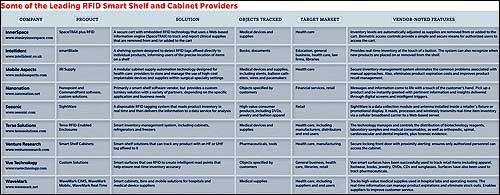Jun 01, 2009Shelves and cabinets outfitted with radio frequency identification technology enable real-time, item-level tracking at an intermediate or final distribution point. These "smart fixtures" are helping retailers, discrete manufacturers, hospitals, and other kinds of companies and organizations control inventories and keep products in continuous stock by automatically tracking the arrival and distribution of individual assets. When you know the number and type of products that are on hand at any given moment, you can prevent over- and under-ordering, saving money and improving efficiencies.
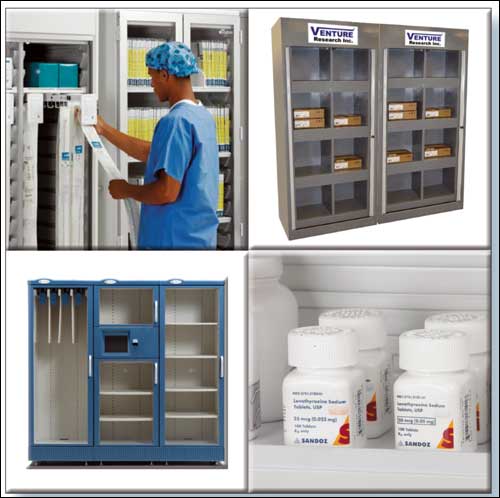
There are several other reasons businesses are acquiring smart-fixture technology:
Quality control. Depending on the software, a smart-fixture system can track data beyond inventory levels, such as product expiration dates, batch numbers and origination points. This information can come in very handy if a product is ever recalled.
On-time and accurate delivery. The smart-fixture service model allows customers or employees to simply grab and take whichever asset they want whenever it's needed.
Enhanced process reliability. The removal of human intervention leads to fewer mistakes in product ordering and sales records.
Reduced shrinkage. Businesses and manufacturers can more easily spot product thefts and theft patterns. In fact, via wireless networking, smart fixtures can even communicate with other security devices—such as RFID interrogators located near point-of-sale (POS) systems and exits—to ensure that assets don't simply "walk away."
While industry advocates and visionaries have long predicted that smart fixtures would soon hold tagged razor blades, soaps, soft drinks and other everyday consumer products, the cost of RFID tags has so far made the tracking of low-priced assets impractical. For now and the foreseeable future, the tracking of high-value products—such as medical devices, pharmaceuticals, jewelry, electronic components and power tools—constitutes the base of the smart-fixtures market. Libraries, law firms, financial services organizations and other businesses that need to store rare books or important documents are also using smart shelves for real-time tracking, so they know if a high-value item is available and, if so, where it's located.
To help you decide which smart-fixture solution might be right for your company or organization, we'll examine the issues you should consider and the features of the various systems. A number of vendors now make solutions geared to specific industries.
Click here to view a larger version of the chart.
Smart-Fixture Hardware
Smart-fixture form factors and designs are limited only by their developers' imaginations. Smart fixtures can be divided into three basic categories:
Smart shelves. Most often used in retail environments, smart shelves—sometimes called "smart surfaces"—allow customers to select and remove an item. Offered by Nanonation, Vue Technology and other vendors, most smart shelves are designed to look and function like traditional, non-RFID-enabled store shelves. For security purposes, a shelf can be integrated into a counter, such as a jewelry display, restricting access to a store's sales personnel.
Smart shelves can also be installed in libraries, pharmacies, offices, supply rooms and a variety of other places that have items stocked on shelves. Intellident is among the vendors that supply technologies targeted at these markets.
Smart cabinets, bins and boxes. Offered by vendors including Mobile Aspects and Terso Solutions, smart cabinets are becoming more common in health-care facilities to store items such as surgical devices and pharmaceuticals. Smart cabinets provide a secure, central location for the distribution of high-value assets. Many cabinets have built-in or optional access controls, such as locks, that are designed to secure high-value items or restricted assets (narcotics, for instance). Refrigerated cabinets are available for storage of pharmaceuticals and other heat-sensitive items.
Beyond the health-care community, smart cabinets enable businesses, law firms, libraries and other enterprises to store and monitor valuable books, contracts and other important documents. In an industrial setting, smart cabinets can hold and track costly or potentially hazardous tools and materials.
In a smart-fixture system, RFID interrogators typically are integrated into the shelf, cabinet or box. This allows tagged assets to be monitored with no direct human intervention.
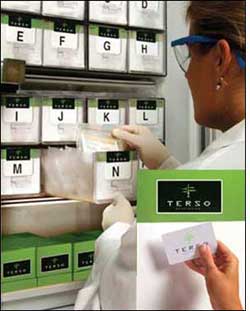
Antenna placement is crucial in smart fixtures. Coverage must be both complete and uniform within the fixture, since the existence of any dead spots would defeat the smart fixture's most important mission: identifying and tracking every item within its perimeter.
Most smart fixtures track small items, such as drug bottles, books and electronic components. This means that RFID tags must be both small and easy to attach. RFID labels are often used, since they can be applied directly to the product surface or packaging and will travel with the item to POS stations, exits and other locations where an enterprise might want to detect an asset. Besides being small and easy to attach, labels are also relatively inexpensive and, in the case of consumer products, usually have little adverse impact on a product's packaging.
Smart-Fixture Software
Smart fixtures by themselves are useful only as storage platforms; it's the software that gives smart fixtures their inherent intelligence. Most smart-fixture software is tied to a specific hardware vendor, with the program developed and supported by either the vendor or a software partner. Key features to look for in smart-fixture software include:
Screens. The software should feature easy-to-read screens that allow users to view and control smart-fixture features and functions quickly and effortlessly.
Reports. The main reason to acquire smart-fixture technology is to gain insight into current and past inventory levels, peak use times and other essential data. The software should allow all of this information to be compiled into customized reports. In addition, error reports will help users maintain and troubleshoot smart-fixture systems.
Web integration. Web support will allow users to view essential smart-fixture data—and to control the system—anytime, anywhere.
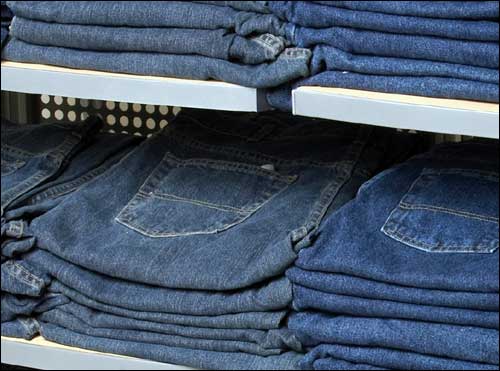
System Design
Although smart fixtures have a more limited coverage area than just about any other type of RFID system, they present many of the same design challenges. You'll need to set project goals, survey vendors, analyze costs and evaluate results.
A key design consideration is the selection of an appropriate form factor. Which is the best approach, a shelf or a cabinet? Does the fixture need to be secure? Where should it be placed? What size should it be? How many individual units will be needed? Who will have access? Who will administer the system? These are just a few of the questions that must be answered before the system can be acquired and deployed.
You'll also have to determine which tagging technology will provide the best performance for the money. Smart-fixture systems from different vendors use various types of tags, and cost can vary widely. Power is another consideration. In critical settings, such as health-care facilities, you'll want to use a backup power source at both the smart fixture and the server to maintain operation during power failures.
Device durability is yet another concern. Smart fixtures take a considerable beating from shoppers, staffers or both, so it's important to look for a product that's technically and physically sound.
Many vendors—particularly those targeting retail customers—offer smart fixtures in a variety of styles and colors. Such vendors are also usually willing to work with customers to create fixtures that match existing shelves and cabinets and won't stand out from surrounding fixtures, attracting unnecessary—and unwanted—attention.
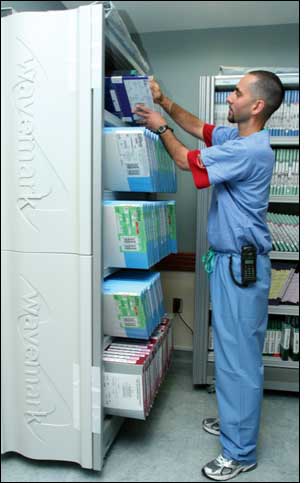
Service and Support
While smart fixtures are edging toward the business mainstream, the technology is still a first-time purchase for most customers. That's why it's important to look for a vendor that can supply not only a suitable smart-fixture environment but also a variety of support services, including system design, technology integration, training, long-term support, and a strategy for future growth and evolution.
Since smart fixtures are typically called on to handle a core business function, it's essential to involve the vendor in every aspect of system planning and deployment. First and foremost, any vendor you select should have experience in your market. In other words, if you're a retailer, it's probably not a great idea to choose a smart-fixture vendor that sells mostly to health-care organizations.
As with any major IT purchase, it's important to research the vendor's history and track record. Be sure to talk with current customers about their experiences, both positive and negative, with the vendor and its products and services. Make sure you're comfortable with the vendor's technology as well as its human representatives. Any confusion or misgivings you may have about any part of the technology or the vendor's responsibilities should be addressed up front before the contract is signed. The contract itself should describe every aspect of the technology, including prices, support services, schedules, performance levels and service response times. Understand that if something isn't in writing, you're probably not going to get it—at least not without paying extra for it.
Finally, seek advice from the people who will actually use the smart-fixture system—your sales staff, physicians, nurses, librarians and others. Find out what they would like the system to do—and not do. After all, being smart is the name of the game.

